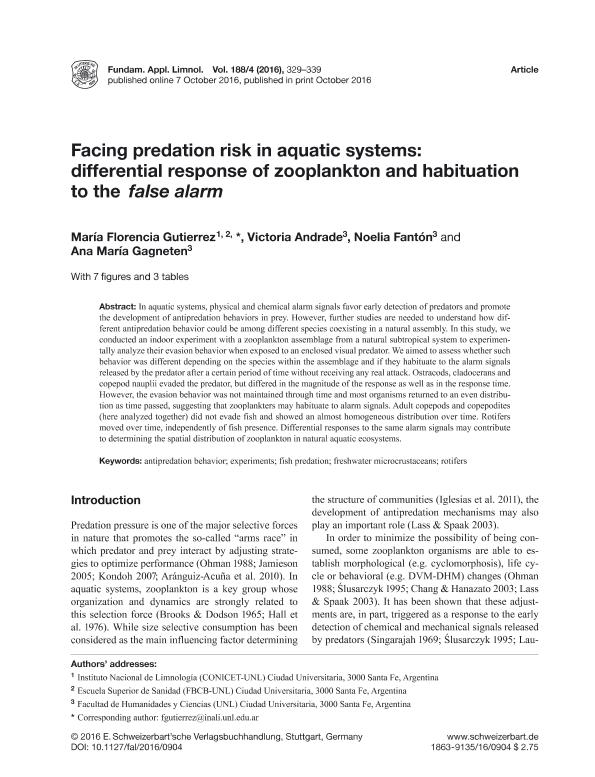Mostrar el registro sencillo del ítem
dc.contributor.author
Gutierrez, Marìa Florencia

dc.contributor.author
Andrade, Victoria Soledad

dc.contributor.author
Fantón, Noelia Isabel

dc.contributor.author
Gagneten, Ana María

dc.date.available
2018-09-16T14:54:06Z
dc.date.issued
2016-11
dc.identifier.citation
Gutierrez, Marìa Florencia; Andrade, Victoria Soledad; Fantón, Noelia Isabel; Gagneten, Ana María; Facing predation risk in aquatic systems: Differential response of zooplankton and habituation to the false alarm; E Schweizerbartsche Verlags; Fundamental and Applied Limnology; 188; 4; 11-2016; 329-339
dc.identifier.issn
1863-9135
dc.identifier.uri
http://hdl.handle.net/11336/59821
dc.description.abstract
In aquatic systems, physical and chemical alarm signals favor early detection of predators and promote the development of antipredation behaviors in prey. However, further studies are needed to understand how different antipredation behavior could be among different species coexisting in a natural assembly. In this study, we conducted an indoor experiment with a zooplankton assemblage from a natural subtropical system to experimentally analyze their evasion behavior when exposed to an enclosed visual predator. We aimed to assess whether such behavior was different depending on the species within the assemblage and if they habituate to the alarm signals released by the predator after a certain period of time without receiving any real attack. Ostracods, cladocerans and copepod nauplii evaded the predator, but differed in the magnitude of the response as well as in the response time. However, the evasion behavior was not maintained through time and most organisms returned to an even distribution as time passed, suggesting that zooplankters may habituate to alarm signals. Adult copepods and copepodites (here analyzed together) did not evade fish and showed an almost homogeneous distribution over time. Rotifers moved over time, independently of fish presence. Differential responses to the same alarm signals may contribute to determining the spatial distribution of zooplankton in natural aquatic ecosystems.
dc.format
application/pdf
dc.language.iso
eng
dc.publisher
E Schweizerbartsche Verlags

dc.rights
info:eu-repo/semantics/openAccess
dc.rights.uri
https://creativecommons.org/licenses/by-nc-sa/2.5/ar/
dc.subject
Antipredation Behavior
dc.subject
Experiments
dc.subject
Fish Predation
dc.subject
Freshwater Microcrustaceans
dc.subject
Rotifers
dc.subject.classification
Otras Ciencias Biológicas

dc.subject.classification
Ciencias Biológicas

dc.subject.classification
CIENCIAS NATURALES Y EXACTAS

dc.title
Facing predation risk in aquatic systems: Differential response of zooplankton and habituation to the false alarm
dc.type
info:eu-repo/semantics/article
dc.type
info:ar-repo/semantics/artículo
dc.type
info:eu-repo/semantics/publishedVersion
dc.date.updated
2018-09-14T13:21:39Z
dc.journal.volume
188
dc.journal.number
4
dc.journal.pagination
329-339
dc.journal.pais
Alemania

dc.journal.ciudad
Stuttgart
dc.description.fil
Fil: Gutierrez, Marìa Florencia. Consejo Nacional de Investigaciones Científicas y Técnicas. Centro Científico Tecnológico Conicet - Santa Fe. Instituto Nacional de Limnología. Universidad Nacional del Litoral. Instituto Nacional de Limnología; Argentina
dc.description.fil
Fil: Andrade, Victoria Soledad. Universidad Nacional del Litoral. Facultad de Humanidades y Ciencias; Argentina
dc.description.fil
Fil: Fantón, Noelia Isabel. Consejo Nacional de Investigaciones Científicas y Técnicas. Centro Científico Tecnológico Conicet - Santa Fe. Instituto Nacional de Limnología. Universidad Nacional del Litoral. Instituto Nacional de Limnología; Argentina
dc.description.fil
Fil: Gagneten, Ana María. Universidad Nacional del Litoral. Facultad de Humanidades y Ciencias; Argentina
dc.journal.title
Fundamental and Applied Limnology

dc.relation.alternativeid
info:eu-repo/semantics/altIdentifier/doi/http://dx.doi.org/10.1127/fal/2016/0904
Archivos asociados
